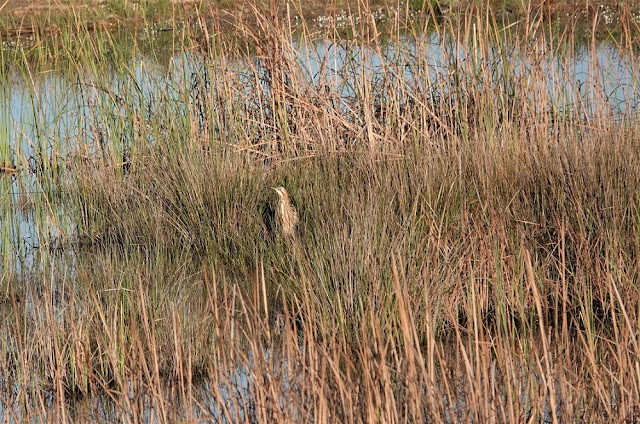Hidden birds
 |
| Great Bittern (Martin Kelsey) |
This morning I had the experience of watching a large marshland bird materialise into view and then through merely a short stride, vanishing. I stood beside a small old gravel pit with patches of reed mace and rushes. Sedge Warblers on their northward migration had stopped here to refuel. Their abrupt calls and occasional little bursts of song gave me some indication of how many there were. Just occasionally I glimpsed them, appearing briefly low in the vegetation. A Purple Heron stood motionless during the entire length of my stay. Sometimes a Moorhen broke cover, but the squealing Water Rails remained hidden from view. I was about to move on when a streaked brownish form appeared. It was that most-compelling of birds, a Great Bittern. It appearance reminded me of a Star Trek teleportation, its body taking form in front of me. A supreme example of an amply-proportioned bird (it is the size of a large goose) that, thanks to its superb camouflage and the slow-fluidity of its movement, can remain undetected in a remarkably small patch of vegetation. It "bitterned" its neck vertical and then hunched down again, before sending its bill horizontally and low to the left, poised in wait for prey. It froze in this posture for several minutes, before recoiling and dissolving before my eyes into the rushes. The apparition vanished.
 |
| Jack Snipe (Martin Kelsey) |
The combination of plumage and behaviour is also deployed by another species whose scientific name Lymnocryptes minimus captures it all: a small bird, hidden in the marsh. It is the Jack Snipe. I remember my first encounter with this tiny wader nearly 50 years ago in a small patch of boggy ground near my home in South Wales. My friend and I had found Water Rails there and it became a favourite haunt on Saturday mornings in the winter. Crossing the patch one day, a streaky brown bird flew up from my feet and quickly dropped again just a few metres away. I managed to see its long, straight bill and knew immediately that it was a Jack Snipe, since unlike the Common Snipe it was silent and did not tower above me when flushed. I saw precisely where it had landed. Venturing across to the spot, I hoped to flush it again, but despite my efforts I never saw it again. Since then over the years, I have seen many Jack Snipe, almost always in the same circumstances. Occasionally I have seen one land in open ground, far enough away for it to feel secure and have watched its extraordinary, almost mechanical, bouncing stance. Its body seems attached to its legs by a carefully controlled spring. But never, ever, had I come across a Jack Snipe at my feet without it flying off first.
Recently, I had come across two or three Jack Snipe in an area of rushy ground where the heavy late winter rain had left muddy puddles. On this occasion, I had set off again and stopped beside one of these puddles, now with much reduced surface water. Looking down, close to my feet, beside some trampled rush stems, was a motionless bird, crouching with its bill flat against the ground. At a casual glance, it would be passed off as a corpse. But the glint in its eye, in which I could even see my reflection, betrayed it as alive. I held my breath and watched. It was a Jack Snipe. I couched too and looked at it. I realised that I had left the camera in the car and silently cursed myself. Then the thought crossed my mind...could I go back for the camera? I back-tracked and walked swiftly back to the car. It was an eight-minute round trip. I was convinced that the bird would have taken my departure as a cue to disappear. As I approached the place a second time, the bird had not moved. I settled down and took some photos. It was only when I paused to look at the back of the camera, that the Jack Snipe was aware that my eye was off it. It sprung upward in flight, arcing around me and dropping into more rushes. And there, I left it in peace.



Comments
I can imagine your dilema return for camera or not! That is why I have always resisted taking photographs but I am weakening! You clearly made the right decision, astonishing photo. Fortune favours the brave!
I remember my first Jack Snipe in some flooded water meadows on the edge of Birmingham (circa 1973). Dr. Clive Minton (my boss!) alerted us to their presence ( he was never wrong! ). Sure enough as we walked through the flooded meadows in bright sunshine Jack Snipe would leap up at our feet and drop down a little further off.
I have always found Jack Snipe elusive (sic ). I am surprised that to date I have not come across one in Donana ( no doubt my own incompetence! ).
Stay safe!
P.J.W.